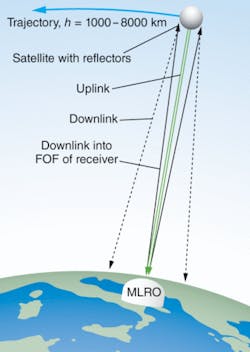QUANTUM COMMUNICATIONS: Single-photon exchange advances Earth-to-space quantum link

A quantum communications link in space is one step closer after Italian researchers successfully detected a single photon sent from Earth to a low-Earth-orbit satellite and back.1 A quantum channel in free space, which works via the exchange of polarization- or phase-encoded photons between transmitter and receiver, is the basis for ultrasecure quantum communications, experiments in quantum mechanics, and eventually even space teleportation. The problem with using photons for free-space communication is that it’s difficult to detect them over a long distance. Recent attempts at free-space quantum links have transmitted single photons over 144 km, but the optical beam was hampered by the atmosphere, environmental vibration, and other obstacles, making further distances impractical.
Now, a team led by Paolo Villoresi, professor of optical and laser nanotechnology at the University of Padua, Italy, has taken the quantum space-link concept to new heights, literally, by sending and receiving a single photon over 1500 km. The group used the Matera Laser Ranging Observatory (MLRO) in Matera, Italy, to direct weak laser pulses toward orbiting satellites in the Satellite Laser Ranging (SLR) network. The SLR satellites are geodesic balls of corner-cube retroreflectors that mirror optical signals on an exact parallel return path to the source. The team chose parameters that would cause less than one photon per pulse to be returned on average, to simulate a single-photon source. Because the signal travels directly up through only 8 km of the Earth’s atmosphere, the link can be established without any deleterious atmospheric or geographic effects (see figure).
The team sent a train of 532 nm pulses measuring 700 ps in duration at a repetition rate of 17 kHz, with 490 nJ of energy per pulse. The pulses were sent toward several SLR satellites via the 1.5 m MLRO telescope, which was equipped with a gated silicon avalanche-photodiode detector and atomic clock to record the timing of the photon emission and return events. The expected detector count rate was closest to ideal (4.6 photons per shot) when reflected from the SLR satellite Ajisai, a 2.15 m sphere covered with 1436 retroflectors and orbiting at a perigee height of 1485 km.
Identifying returning photons
Single photons encoded with polarization or phase information are the key to secure quantum-encrypted communication. Such a system would need the ability to discriminate which photons are part of the signal, and to identify them. Using an interference bandpass filter and a low-scatter Glan polarizer across a field of view narrowed to an optimal 30 arcsec, the team confirmed it was possible to discriminate the returning photons from spurious ones over the 1500 km distance. Exact event timing was synchronized and coordinated with the International Laser Ranging Service (ILRS) network database, to an accuracy of better than 1 ns. A statistical peak ∆t = 5 ns identified the average return time of a photon in the pulse, which agreed with predictions. The group verified that return time was stable over varying temporal bin sizes. Total system attenuation along the light path of -157 dB correlated to the photon return rate data observed for Ajisai.
“Our experiment is an extension of scientific results obtained on Earth, and underlines the feasibility of space-to-Earth quantum communications with existing technology,” said Villoresi. “It could also be useful in the study of fundamental issues such as teleportation, quantum distribution keys, and the study of space-time behavior.” The next step for Villoresi and his group, along with collaborators at the Academy of Sciences in Vienna, Austria, and the Italian Space Agency, is to design a dedicated payload with a transmitter to be mounted on an orbiting space station, and perhaps eventually, to investigate the practicality of a spaceborne entangled-photon source, necessary for quantum teleportation experiments. (See video at www.laserfocusworld.com/articles/330299)
REFERENCE
1. P. Villoresi et al., New J. of Phys. 10, 033038, (2008).
About the Author
Valerie Coffey-Rosich
Contributing Editor
Valerie Coffey-Rosich is a freelance science and technology writer and editor and a contributing editor for Laser Focus World; she previously served as an Associate Technical Editor (2000-2003) and a Senior Technical Editor (2007-2008) for Laser Focus World.
Valerie holds a BS in physics from the University of Nevada, Reno, and an MA in astronomy from Boston University. She specializes in editing and writing about optics, photonics, astronomy, and physics in academic, reference, and business-to-business publications. In addition to Laser Focus World, her work has appeared online and in print for clients such as the American Institute of Physics, American Heritage Dictionary, BioPhotonics, Encyclopedia Britannica, EuroPhotonics, the Optical Society of America, Photonics Focus, Photonics Spectra, Sky & Telescope, and many others. She is based in Palm Springs, California.
